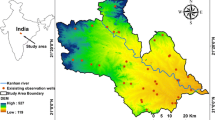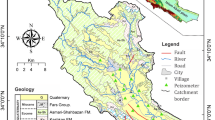Abstract
As the purpose of the regional groundwater monitoring station is to observe both quality and the levels of groundwater in South Korea, it is most efficient and economical to establish the monitoring station at a site able to observe these two items simultaneously. A weighting and ranking method using GIS technology was used for the development of a site selection model. This model uses a land-use type of target area with regard to quality and a lineament length density with regard to quantity. It was shown that this weighting and ranking method is appropriate and convenient for selecting a monitoring site because it proposes the relative importance and priority of groundwater monitoring for each site. Additionally, if this method is used together with the other method like an analytical hierarchy process (AHP) method, the optimal and specific monitoring site can be easily selected and the additional field investigation can be reduced.
Similar content being viewed by others
References
Andricevic R, Foufoula-Georgiou E (1991) A transfer function approach to sampling network design of groundwater contamination. Water Resour Res 27(10):2759–2769
Ben-Jemaa F, Marino MA, Loaiciga HA (1995) Sampling design for contaminant distribution in lake sediments. J Water Resour Plan Manage ASCE 121(1):71–79
Blickwedel RS, Wood CR (1988) Relation of ground-water quality to land use in the Philadelphia—Camden, New Jersey Area. US Geological Survey Water Resources Investigations Rep. 88–4211, US Department of the Interior, Denver, pp 58
Briz-Kishore BH (1993) Assessment of yield characteristics of granitic aquifers in South India. Groundwater 31:921–928
Daniel CC (1989) Statistical analysis relating well yield to construction practices and siting of wells in the Piedmont and Blue Ridge provinces of North Carolina. US Geological Survey Water Supply Paper 2341-A, USGPO, Denver, Colorado, pp 27
de Olivares GH (1998) Cost effective groundwater quality sampling network design. PhD thesis, University of Vermont, Vermont, pp 158
EPA (1990) Handbook: ground water volume 1: groundwater and contamination, EPA/625/6-90/016a. US Environmental Protection Agency, Washington, DC, pp 144
EPA (1994) Handbook: ground water and wellhead protection, EPA/625/R-94/001. US Environmental Protection Agency, Washington, DC, pp 267
Gibbons RD (1991) Statistical tolerance limits for groundwater monitoring. Groundwater 29:563–570
Gibbons RD (1994) Statistical methods for groundwater monitoring. Wiley, New York, pp 286
Gilliom RJ, Alley WM, Gurtz ME (1995) Design of the national water quality assessment program: occurrence and distribution of water quality condition. US Geological Survey Circular 1112. US Geological Survey, Sacramento, pp 28
Gustafsson P (1994) Spot satellite data for exploration of fractured aquifers in a semi-arid area in southeastern Botswana. Appl Hydrogeol 2:9–18
Hudak PF, Loaiciga HA, Schoolmaster FA (1993) Application of geographic information systems to groundwater monitoring network design. Water Resour Bull 29:383–390
Jia J, Fisher GW, Dyer JS (1997) Attribute weighting methods and decision quality in the presence of response error: a simulation study. The University of Texas at Austin, Texas, pp 43
Kim GB (2005) Nationwide monitoring and assessment of groundwater in Korea. PhD thesis, Seoul National University, Seoul, Korea, pp 391
Kim GB, Lee JY, Lee KK (2004a) Application of representative elementary area (REA) to lineament density analysis of groundwater implications. Geosci J 8(1):27–42
Kim GB, Lee JY, Lee KK (2004b) Construction of lineament maps related to groundwater occurrence with ArcView and Avenue™ scripts. Comput Geosci 30:1117–1126
Kim JW, Lee JY, Yi MJ, Kim GB, Won JH, Lee KK (2007) Allocating local groundwater monitoring stations for South Korea using an analytic hierarchy process. Hydrogeol J 15:615–632
Knopman DS, Hollyday EF (1993) Variation in specific capacity in fractured rocks, Pennsylvania. Groundwater 31:135–145
Lee YM, Ellis JH (1996) Comparison of algorithms for nonlinear integer optimization: application to monitoring network design. J Environ Eng 122(6):524–531
Lee JY, Yi MJ, Yoo YK, Ahn KH, Kim GB, Won JH (2007) A review of the National Groundwater Monitoring Network in Korea. Hydrol Proced 21:907–919
Loaiciga HA, Charbeneau RJ, Everett LG, Fogg GE, Hobbs BF, Rouhani S (1992) Review of groundwater quality monitoring network design. J Hydraul Eng 118(1):11–37
Mabee SB, Hardcastle KC, Wise DU (1994) A method of collecting and analyzing lineaments for regional-scale fractured-bedrock aquifer studies. Groundwater 32:884–894
Malczewski J (1999) GIS and multicriteria decision analysis. Wiley, New York, pp 178
Meyer PD, Ranjitham R, Valocchi AJ, Eheart JW (1989) Groundwater monitoring network design using coupled Monte Carlo simulation and optimization. In: Proceedings of the 1989 national conference on hydraulics engineering. ASCE, New York, pp 404–409
MOCT (Ministry of Construction and Transportation) (2002) Master plan of groundwater in Korea. Seoul, pp 112
MOCT (Ministry of Construction and Transportation) and KOWACO (Korea Water Resources Corporation) (2002) Installation and management of local groundwater monitoring network: research report. Seoul, Korea, pp 271
MOCT (Ministry of Construction and Transportation) and KOWACO (Korea Water Resources Corporation) (2003a) Report for basic groundwater survey in Cheonan region. Seoul, Korea, pp 400
MOCT (Ministry of Construction and Transportation) and KOWACO (Korea Water Resources Corporation) (2003b) Report for basic groundwater survey in Pohang region. Seoul, Korea, pp 502
MOCT (Ministry of Construction and Transportation), KOWACO (Korea Water Resources Corporation), KORES (Korea Resources Corporation) (2003) Report for basic groundwater survey in Milyang region. Seoul, Korea, pp 230
MOE (Ministry of Environment) (2002) Plan for the management of groundwater quality monitoring stations in 2002. Seoul, Korea, pp 30
Neves MA, Morales N (2007) Structural control over well productivity in the Jundiai River Catchment, Southeastern Brazil. An Acad Bras Cienc 79:307–320
Park YJ, Lee KK, Kim JM (2000) Effects of highly permeable geological discontinuities upon groundwater productivity and well yield. Math Geol 32:605–618
Pope LM, Bruce BW, Rasmussen PP, Millagan CR (2002) Quality of shallow ground water in areas of recent residential and commercial development. US Geological Survey Water Resources Investigation Report 02-4228, US Department of the Interior, Lawrence, pp 67
Risser DW, Siwiec SF (1996) Water quality assessment of the lower Susquehanna river basin: Pennsylvania and Maryland: environmental setting. US Geological Survey Water Resources Investigation Report 94-4245, US Geological Survey, Denver, pp 70
Robinson JL (2002) Ground water quality beneath an urban residential and commercial area, Montgomery, Alabama, 1999–2000. USGS Water Resources Investigation Report 02-4052, US Department of the Interior, Montgomery, pp 37
Saaty TL (1980) The analytic hierarchy process: planning setting priorities, resource allocation. McGraw-Hill, New York, pp 287
Sander P (2007) Lineaments in groundwater exploration: a review of applications and limitations. Hydrogeol J 15:71–74
Sander P, Chesley MM, Minor TB (1996) Groundwater assessment using remote sensing and GIS in a rural groundwater project in Ghana: lessons learned. Hydrogeol J 4:40–49
Sander P, Minor TB, Chesley MM (1997) Ground water exploration based on lineament analysis and reproducibility tests. Groundwater 35:888–894
Siddiqui SH, Parizak RR (1971) Hydrogeologic factors influencing well yields in folded and faulted carbonate rocks in central Pennsylvania. Water Resour Res 7:1295–1312
Sidle WC, Lee PY (1995) Estimating local ground water flow conditions in a granitoid: preliminary assessments in the Waldoboro pluton complex, Maine. Groundwater 33:291–302
Sloto RA (1987) Effect of urbanization on the water resources of eastern Chester County, Pennsylvania. US Geological Survey Water Resources Investigations Report 87-4098, US Department of the Interior, Denver, pp 131
Sophocleous M, Paschetto JE, Olea RA (1982) Groundwater network design for Northwest Kansas using the theory of regionalized variables. Groundwater 20:48–58
Storck P, Eheart JW, Valocchi AJ (1997) A method for the optimal location of monitoring wells for detection of groundwater contamination in three-dimensional heterogeneous aquifers. Water Resour Res 33(9):2081–2088
US Geological Survey (1999) The quality of our nation’s water—nutrients and pesticides. US Geological Survey Circular 1225, US Department of the Interior, Reston, pp 82
Van Duijvenbooden, Taat WJ, Gast LFL (1985) The national groundwater quality monitoring network: final report of the installation. Bilthoven report no. 840382001, National Institute of Public Health and Environmental Protection, The Netherlands
Vecchia AV (2003) Water-quality trend analysis and sampling design for streams in North Dakota, 1971–2000. USGS Water Resources Investigation Report 03–4094, US Department of the Interior, Bismarck, pp 73
Waller BG (1983) Effects of land use on ground water quality in the east Everglades, Dade county, Florida. USGS Water Resources Investigations 82–4093, US Department of the Interior, Tallahassee, pp 67
Author information
Authors and Affiliations
Corresponding author
Rights and permissions
About this article
Cite this article
Kim, G. Integrated Consideration of Quality and Quantity to Determine Regional Groundwater Monitoring Site in South Korea. Water Resour Manage 24, 4009–4032 (2010). https://doi.org/10.1007/s11269-010-9644-6
Received:
Accepted:
Published:
Issue Date:
DOI: https://doi.org/10.1007/s11269-010-9644-6




